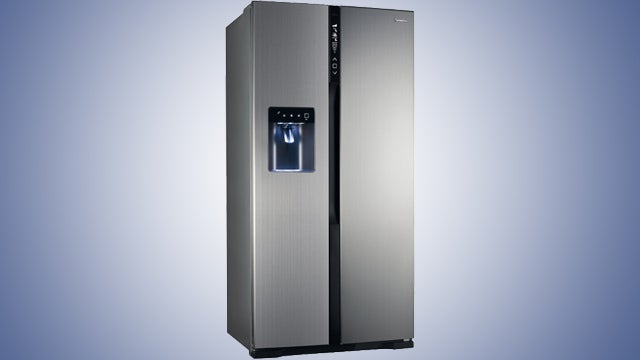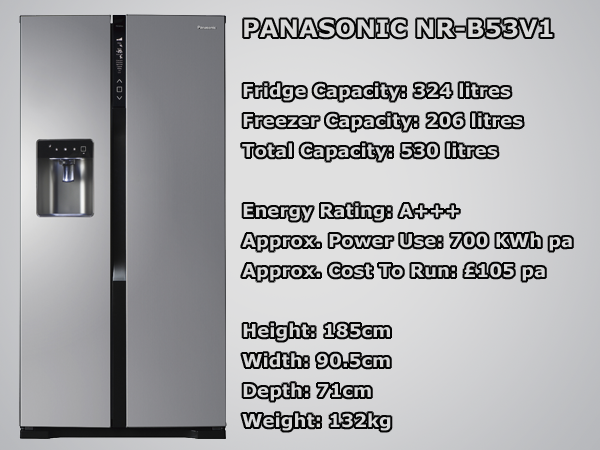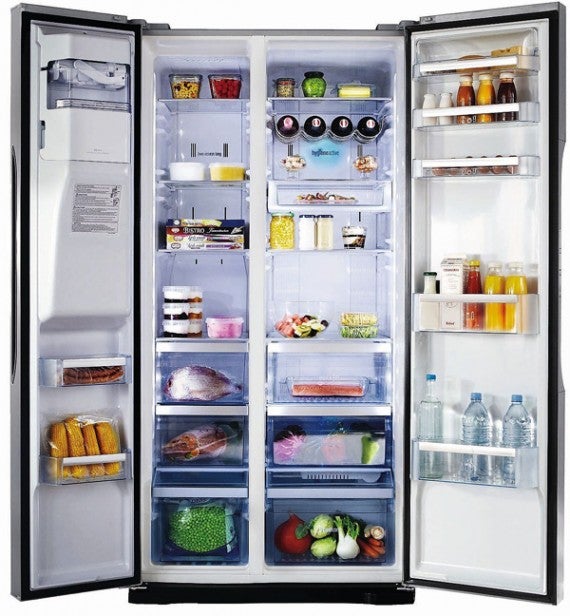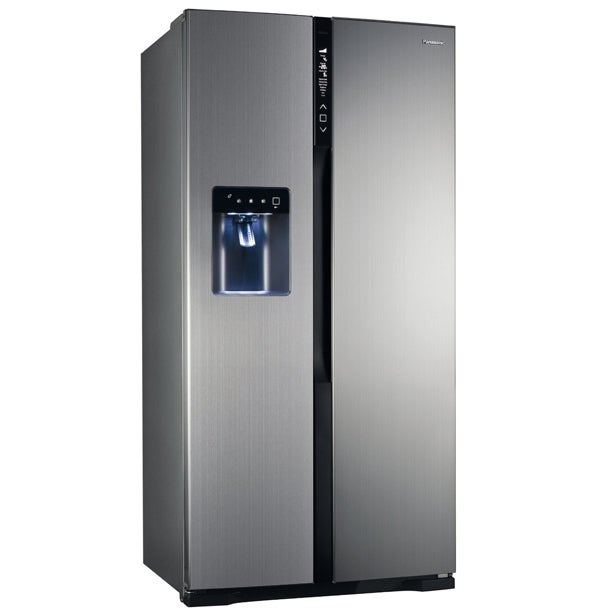Panasonic NR-B53V1 Review
Panasonic NR-B53V1
A huge, accomplished and stylish American-style fridge freezer, albeit one with some quirks

Verdict
Pros
- Sleek contemporary design
- Great water and ice system
- Touch controls
- Incredibly quiet
Cons
- Slow illuminating internal lighting
- Limited drawer space in freezer
- Minor temperature fluctuation in bottom freezer drawer
What is the Panasonic NR-B53V1?
This NR-B53V1 is Panasonic’s top-of-the-range US-style side-by-side fridge freezer and it is an imposing beast. It claims to be one of the most energy efficient on the market due to its Inverter compressor technology, U-Vacua vacuum insulation panel and Twin-Eco cooling system. The energy efficiency is further enhanced by the use of a number of sensors to automatically select the optimum power level required to efficiently run the refrigerator on minimum power at times of low usage, such as overnight.
The U-Vacua insulation is an ultra-thin vacuum insulation panel that Panasonic claims performs 20 times better than standard refrigerator insulation. The Twin-Eco cooling system allows you to independently control the fridge and freezer, unlike traditional systems that cool both at the same time. The stylish interior has ample grocery storage including a Vitamin-Safe compartment with an independent temperature control to help increase the storage time for fruit and vegetables.
SEE ALSO: Washing Machine Reviews

Panasonic NR-B53V1: How does it look?
The anti-fingerprint stainless steel finish is sleek-looking and the overall design is neat and contemporary. The integral handles formed as the side of each doors adjoining the central recess is eye-catching and serves as home to the touch LED control panel. This controls the main refrigerator and the ice/filtered water dispenser, which illuminate and beep when touched, dimming off 30 seconds later.
On opening the doors both sections are illuminated by front tower LED lights that start dim and get brighter over a couple of seconds. The soft start lighting is a wow-factor feature when you first have the fridge, but for a speedy dip in for the milk it’s a bit sluggish. Still, on looks alone, the Panasonic NR-B53V1 is every bit as classy as its price suggests.
Panasonic NR-B53V1: How much can you fit in?
The 206-litre freezer has three clear plastic drawers and four shelves, the top two being adjustable. In the door there are two fairly deep drawer pockets for smaller items that you might want access to more frequently. But it’s the cavernous 324-litre fridge compartment is the star of the show here. It has four tempered glass shelves, the top three being adjustable, a compact drawer midway for smaller items and three large clear drawers towards the bottom. The first of these is a meat and fish drawer to help keep these raw items separate from the rest of the groceries.
Next down is the Vitamin-Safe drawer with its separate temperature control from zero to five degrees, designed to help fruit and vegetables keep fresher for longer. This drawer and the bottom drawer have blue and green LEDs permanently flashing that, Panasonic tells us, simulates the natural hues of daylight and encourages fruit and veg to activate their own natural defences, which in turn prevents loss of vitamins. We couldn’t test this and remain a bit sceptical, but the fact you can set a dedicated lower temperature for your fruit and veg is very useful.
SEE ALSO: Best American Fridge Freezer Round-up

In the door, the enormous door pockets would hold the largest of US super-sized milk or ‘soda’ bottles, but Panasonic has thoughtfully provided a curvy divider that allows several smaller bottles to be stored in the doors. The usual fair of egg trays and door compartments are all well thought out and the internal furniture is complete with a removable, hanging wine rack.
This Panasonic’s trump card is the fully plumbed-in and filtered in ice and chilled water dispenser in the door. The ice maker can produce up to 60 ice cubes per day, supplied cubed of crushed. A filter and pluming-in kit with 5m hose is supplied and most homes could plum this in using a simple Y-piece adapter from their washing machine plumbing.
Panasonic NR-B53V1: How noisy is it?
It isn’t. No really, it is mind bogglingly quiet and by a solid margin the quietest refrigerator we have yet tested. While Panasonic’s own literature claims 38dB of noise we measured a staggering 35-36dB (A-weighted, which best represents human hearing) even when the compressor was running.
In fact we struggled to measure the noise from the Panasonic at all, and had to do our tests in the wee small hours of the morning so that the background ambient noise was low enough for the Panasonic to register on our test equipment. It is noticeably quieter than several other fridge freezers we have tested that also claim 38dB too. So for those who appreciate a bit of peace and quiet in the kitchen, the Panasonic is a star performer.
Panasonic NR-B53V1: What is it like to live with?
The NR-B53V1 more than justifies its premium price tag with a great package of features, usability and superb fit and finish. It is absolute eye-candy from the outside and true to Panasonic’s claim the brushed stainless steel finish is amazingly resistant to finger print marks. The central gloss black trim is very classy (although more prone to finger marks) and the bold white icons and temperature indicators really stand out. These disappear 30 seconds or so after touching the control to save energy and look less ostentatious.
The chilled water and ice dispenser worked faultlessly, although the dispenser really requires a large, probably US-size, cup to avoid some of the crushed ice missing the mark and splashing your hand. The whole dispenser area illuminates when you touch the control panel although, being picky, having to touch the control panel before it will dispense is a bit clunky and the supplied drip tray is likely to hold not much more than, well, a drip.
On the inside Panasonic’s attention to detail simply shines through in the usability and supplied fridge and freezer furniture. In the fridge, the drawers are cavernous, the shelves are easy to reposition and the door pockets are big enough to qualify as a fridge in their own right. The drawers slide in and out with consummate ease, and even with some fairly energetic door opening we could not get any bottles in the door to leap out spontaneously. We remain rather sceptical about the efficiency of the green/blue LEDs for keeping your veggies fresh and only time will tell if this is a feature that gets forgotten or becomes standard on every fridge on the market.
Considering the overall size of the NR-B53V1, the actual freezer capacity is a little underwhelming and the fairly narrow enclosure is going to cause real problems if you like to freeze enormous pizzas or large turkeys. That said the capacity is still more than a 60cm under counter freezer and at least you won’t need space for ice-cube trays. We would have perhaps liked more drawers than shelves in the freezer compartment, but the additional freezer door pockets certainly came in useful for small impulse items like ice lollies for the kids and Mini Magnums for the adults. Overall, this flagship Panasonic is a triumph of design, ergonomics and usability with only the very smallest of niggles.
Panasonic NR-B53V1: How well does it perform?
In fridge and freezer tests, this Panasonic turned in a solid if not exceptional set of results. We set the fridge to 4 degrees, the freezer to -20 degrees and the Vitamin-Safe drawer to 2 degrees and loaded compartments for medium household usage (1kg food / 10litres capacity in the freezer, 0.5kg food / 10 litres in the fridge). This included 2 litres of room temperature water with a middle sensor to check the fresh-to-frozen and power-off defrost rates of the freezer. We mapped the temperature in four different zones of each compartment over a 48-hour period, taking readings every minute for greatest accuracy.
The Panasonic brought our 2 litres of water to -18degrees at its centre in a very respectable 18hours, indicating that fresh food would get below freezing reasonably quickly. Throughout the 2-day test (opening the doors 6 times per day) the air temperature range measured an average /- 4 degrees, with the bottom shelf running typically 2 degrees cooler than the top shelf most of the time. Our frozen food remains within a very respectable /-1 degree of -20 degrees throughout. But of some concern were temperature measurements from the lowest freezer compartment, which showed some brief but alarming air temperature peaks up to -5 degrees. These peaks often followed a period of intense chilling by the compressor, indicating some heating from the motor affecting the lower compartment.
Over the 3-hour power-cut test the internal air temperature showed a steady rise to -14 degrees on the mid shelf and -12 degrees on the top shelf, while the bottom draw again performed worse reaching -4 degrees after three hours. Our frozen food on the mid-shelf raised to just -15 degrees internally, making Panasonic’s claim of 16 hours safety limit (before food has effectively defrosted) pretty accurate. Overall, the freezer compartment was a bit more peaky and erratic than we would have liked to have seen although the actual frozen food temperature remained consistent.
The chiller cabinet was a more stable performer and showed very consistent food and air temperature results. Throughout the test the entire compartment stayed between 1.0 degree and 5.0 degrees, with the suspended middle shelf compartment showing the most consistent temperature throughout the test. This varied just /-0.5 degrees, so would be idea to keep foods like cheeses. The meat compartment drawer stayed uniformly 1.0 degree lower than the top shelf, both of which varied by less than 1.5 degrees either side of their average temperature.
The only real anomaly was the food fresh zone in the bottom drawer. On one hand the temperature was most consistent overall, wavering fractionally either side of 4.0 degrees, yet seemed to have regular spikes at three to four-hour intervals. While these temperature spikes were short-lived, less than a few minutes, they did peak at 6.0 degrees and dip to -2.0 degrees on the recovery potentially causing some frost issue on the surface of delicate foods.
Panasonic NR-B53V1: How much will it cost to run?
Not very much for its ample food capacity, but certainly a lot more than Panasonic’s figures. During the test we never got close to the 345kWh/year stated in the brochure and we calculate it is more likely to be around 700kWh per year (£105*), unless you very rarely access your fridge freezer or keep your kitchen at arctic temperatures in the winter. We are yet to test a refrigerator that actually achieves its stated energy efficiency in real everyday use, so Panasonic is not alone in this. And, considering the huge fridge capacity, sizeable freezer and all the ice-making gadgetry, 700kWh/year is not a bad result at all.
SEE ALSO: Best Fridge Freezer Round-up

Should I buy the Panasonic NR-B53V1?
Even though the NR-B53V1-BX will actually be approximately twice as expensive to run as the brochure suggests, it remains a stylish, feature-packed and relatively energy efficient for its size. It chills and freezes food very quickly and it will keep your food safe in a power-cut for up to 16 hours, which is average for US-style models.
The temperature tests do throw up a few anomalies but none we feel will have any major detrimental effect on your foods – and it is almost certainly much more consistent than your old fridge freezer that it will be replacing. It is superbly featured, the design and finish are exemplary, the water and ice dispenser is great and the running noise, the lowest we have ever measured, is an added bonus.
ROUND-UP: Best Hand Blenders
| Test | |
|---|---|
| Approx annual power consumption | 700 KWh |
| Approx annual running cost | Ł105 |
| Running Noise (A weighted) | 35-36dB |
| Max freezer (air)temp after 3hr fail | -4 degrees |
| Max freezer (food) temp after 3hr fail | -16 degrees |
| Frozen safety limit (food to 0 degrees) | Approx. 16hours |
| Recovery time to -20 (air) after 3hr fail | 36 minutes |
| Average Freezer temp variation | -17 to -23 degrees |
| Average Fridge temp variation | 1 to 5 degrees |
*Based on the average UK household with ambient temperature between 17-20 degrees, opening fridge and freezer 6 times per day each, running 365 days per year.
*Based on an average 15p per KWh at time of review


